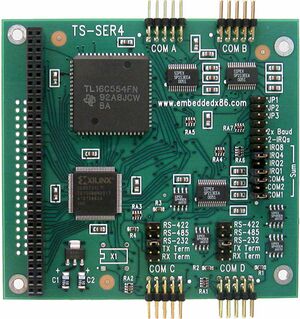TS-SER4
 | |
| Product Page | |
| Documents | |
|---|---|
| Schematic | |
| Mechanical Drawing |
Overview
The TS-SER4 is a PC/104 expansion card with four serial ports using the PC standard 16C550 type UARTs (with 16-byte FIFOs). All four COM ports support RS-232 levels and two of these COM ports can optionally support RS-422/ RS-485 levels.
A flexible interrupt sharing design allows for a large number of COM ports using a minimum number of interrupts. An interrupt status register allows rapid identification of the interrupt source.
This product uses a multi-layer PCB with power and ground planes to minimize noise and EMI issues. The TS-SER4 only requires a single 5V power supply.
Getting Started
See your SBC's PC104 section for information on the ISA 16550 driver and getting a connection to the COM device.
Serial Ports
The two serial ports that are labeled COM_A and COM_B support RS-232 levels only. The two serial ports labeled COM_C and COM_D support a subset of RS-232C handshakes lines that is sufficient for the vast majority of applications. In addition these two ports can optionally have RS-485/RS-422 drivers. The table below shows these ports.
COM/IO Selection
| JP14 | JP15 | JP18 | COMA | COMB |
|---|---|---|---|---|
| On | On | On | 2e8 | 3e8 |
| On | Off | On | 2f8 | 3f8 |
| Off | On | On | 260 | 268 |
| Off | Off | On | Disabled | Disabled |
| On | On | Off | 250 | 258 |
| On | Off | Off | 220 | 228 |
| Off | On | Off | 210 | 218 |
| Off | Off | Off | Disabled | Disabled |
| Note: | JP18 is shared with the parallel port |
Parallel Port
The parallel port is a standard PS/2 mode bidirectional port. It can be assigned to 5 different I/O locations or disabled completely. The parallel port can use interrupts 7 and 9. To select the desired interrupt, simply install a jumper on the associated pins in the IRQ jumper block.
| JP16 | JP17 | JP18 | LPT Address |
|---|---|---|---|
| On | On | On | 278 |
| On | Off | On | 378 |
| Off | On | On | 3bc |
| Off | Off | On | Disabled |
| On | On | Off | 278 |
| On | Off | Off | 27c |
| Off | On | Off | 37c |
| Off | Off | Off | Disabled |
X1 and Non-standard Baud Rates
The TS-SER4 has a socket for a 5V 8-DIP, 4 Leads (half size, metal can) oscillator. By default, the TS-SER4 uses a clock (1.8432MHz) from the PC104 bus which has a maximum baud rate of 115200. When a signal is detected on the X1 socket, it will use the clock from there instead.
Typically you will use 'setserial' to configure the port. For example, lets assume you have a 7.3728MHZ and your target baud rate is 230,400. Your baud_base is 7,372,800/16=460,800. This will also be your maximum baud rate. To reach custom baud rates, you must divide this value by an integer. In our case, the divisor would be 2 to reach 230400.
setserial /dev/ttyS4 spd_cust baud_base 460800 divisor 6
| Note: | Custom baud rates can be up to 5% off of your target baud rate, and communication will still be possible with most devices. |
Linux allows you to access this custom baud rate by essentially overwriting the ioctl used when setting your baud rate to 'B38400'. The Linux Documentation Project has more details on serial programming.
Product Notes
FCC Advisory
This equipment generates, uses, and can radiate radio frequency energy and if not installed and used properly (that is, in strict accordance with the manufacturer's instructions), may cause interference to radio and television reception. It has been type tested and found to comply with the limits for a Class A digital device in accordance with the specifications in Part 15 of FCC Rules, which are designed to provide reasonable protection against such interference when operated in a commercial environment. Operation of this equipment in a residential area is likely to cause interference, in which case the owner will be required to correct the interference at his own expense.
If this equipment does cause interference, which can be determined by turning the unit on and off, the user is encouraged to try the following measures to correct the interference:
Reorient the receiving antenna. Relocate the unit with respect to the receiver. Plug the unit into a different outlet so that the unit and receiver are on different branch circuits. Ensure that mounting screws and connector attachment screws are tightly secured. Ensure that good quality, shielded, and grounded cables are used for all data communications. If necessary, the user should consult the dealer or an experienced radio/television technician for additional suggestions. The following booklets prepared by the Federal Communications Commission (FCC) may also prove helpful:
How to Identify and Resolve Radio-TV Interference Problems (Stock No. 004-000-000345-4) Interface Handbook (Stock No. 004-000-004505-7) These booklets may be purchased from the Superintendent of Documents, U.S. Government Printing Office, Washington, DC 20402.
Limited Warranty
See our Terms and Conditions for more details.